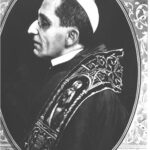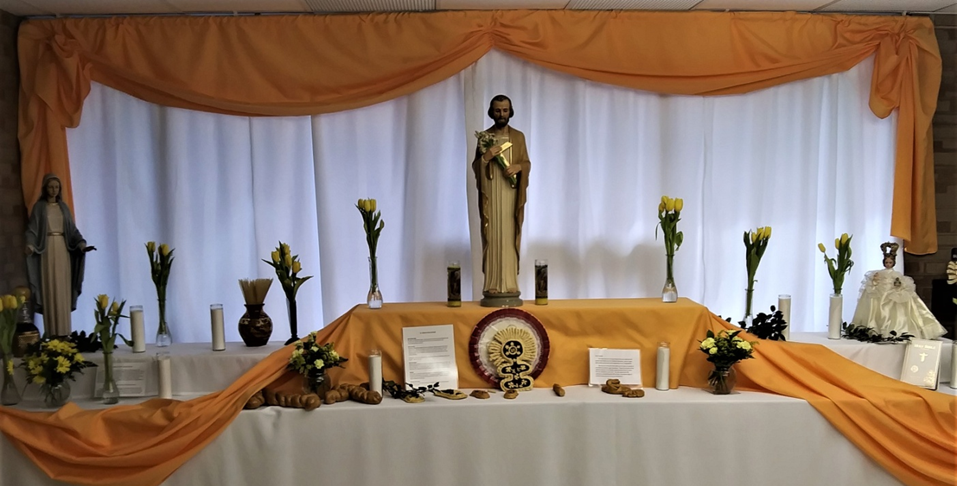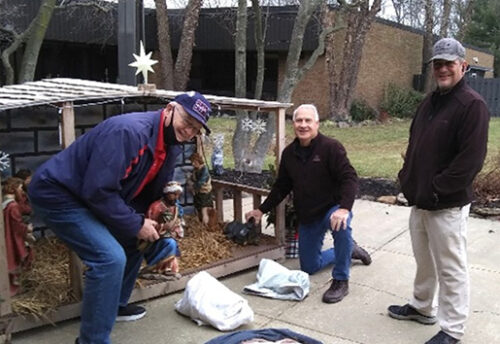
The Silent Knight – Saint Joseph

This spectacular view of our Saint Joseph Statue standing outside our Saint Mary Unit more than adequately portrays the ever-present spirit of Saint Joseph who, over the years, continues to surround and protect the Little Sisters of the Poor, their homes, and all those who dwell within.
We have no written account of anything Saint Joseph may have said during his lifetime, and precious little account of his actions. Yet Saint Joseph has been named by the Catholic Church, “Terror of Demons” among other more easily identifiable names. And it is precisely in the lack of written accounts of his words and actions that we find his true strength. Vividly portrayed in this photograph, he stands, strong, silent, present, formidable. No wonder demons flee.
It is evident that Saint Jeanne Jugan became aware of the powerful intercession of Saint Joseph from the earliest days of her ministry. The first written account of Saint Jeanne Jugan calling upon Joseph for help (with miraculous results) can be found in the archives of the very first home she established. Jeanne was about 46 years old.
From that time on, the Little Sisters of the Poor from all over the world have called upon his intercession and he never fails them.
Over time, each of her homes began to honor his feast day in a special way, with visits from bishops and cardinals. Soon a tradition developed within the congregation. They would host a special dinner in honor of Saint Joseph on his feast day and would invite others from their towns or villages to join them. One such dinner became especially memorable.
 In March of 1909 Archbishop della Cheisou came to celebrate the feast day with the sisters, and, wearing a simple white apron, humbly served the noon meal to the residents. Having enjoyed himself so much, the archives tell us that he told the Residents, “For fear that the sisters might forget to invite me next year, I am going to reserve my place at once.”
In March of 1909 Archbishop della Cheisou came to celebrate the feast day with the sisters, and, wearing a simple white apron, humbly served the noon meal to the residents. Having enjoyed himself so much, the archives tell us that he told the Residents, “For fear that the sisters might forget to invite me next year, I am going to reserve my place at once.”
But this was not to be ~ for the next year he was “raised to the chair of Peter as Pope Benedict XV – so he sent his picture instead with a letter of regret and his blessings.”
From that time on, every Pope has honored the special protection of Saint Joseph for the Little Sisters of the Poor – even to this present day.
It has been 150 years since Blessed Pope Pius IX declared Saint Joseph Patron of the Catholic Church so that all could better appreciate this humble carpenter and his central role in the history of salvation. Now, during his tenure, Pope Francis declared the Year of St. Joseph from December 8, 2020 -December 8, 2021, and had the name of Saint Joseph inserted into every Eucharistic prayer so that the name of Joseph is mentioned in all the Masses said throughout the world. He invites all Catholics to imitate the example of Saint Joseph, whom he calls, “an ordinary man who fulfilled his purpose through obedience, love and trust in God.” (Patris Corde (With a Father’s Heart), Apostolic Letter, December 8, 2020 – Feast of the Immaculate Conception.)
Because the Feast of Saint Joseph fell on a Sunday in Lent this year, the Catholic Church chose the next day, Monday, March 20th, to celebrate his feast day.
Here at our Home, our Bishop Emeritus Malooly came to celebrate Mass with us and to bless our special three-tiered altar which must be carefully built each year from scratch, and adorned with very specific and symbolic ornaments, to honor Saint Joseph during the month of March.
It takes a small but effective group of Volunteers, Staff, Sisters, and Residents to build the altar, decorate it and bake the special breads, cakes, and cookies, which are then blessed and distributed.
In the Scripture readings for March 19 of this year, we hear the story of the call of David, the humble shepherd boy called by God to become the unlikely king of the Jews. So, too had God called the humble, obedient, and mightily meek Joseph to be the Protector of His only Son.

SYMBOLS ON THE SAINT JOSEPH ALTAR
Three-Tiered Altar
The altar is constructed in three tiers representing the three Persons in the Blessed Trinity. Three in One. A statue of Joseph or a picture of the Holy Family is placed on the top tier surrounded by flowers, greenery, and fruit.
Blessing of the Altar
All of the items on the altar (food, candles medals, holy cards, and Fava beans
are blessed by a priest in a ceremony held the afternoon before an altar is broken” (meaning that the food is shared with others gathered at the ceremony).
That evening people may visit to pray and to leave petitions.
Donations are collected for the poor.
Fresh Green Branch
A fresh green branch is placed over the door of the place/room where the altar is erected. It indicates that the public is invited to be involved in the ceremony
and to share the food.
Saint Joseph’s Bread
This is specially prepared bread and cakes, blessed, and distributed at the altar.
This bread is baked in symbolic shapes:
lilies, staff, sandals, a ladder, a saw, a hammer & nail.
It may be eaten but is often saved.
During a storm, a small piece is thrown outside and prayers are said in hopes that the storm will abate.
The Fava Bean
This is the most well-known custom associated with the St. Joseph Altar.
During a severe famine in Sicily, the Fava bean thrived when other crops failed. Originally grown for animal fodder, because of its resilience,
it became the sustaining food for farmers & their families.
The dried bean is called the “lucky bean.”
Legend states that the person who has one is never without coins.
Begging
All food on the altar is obtained by “begging” for donations. The altar must not incur any expense. In the spirit of St. Joseph whose who have been favored with good fortune continue to share these blessings with those in need.
Donations & food on the altar are sent to the poor.
There is never any personal profit gained from the altar.
When these things are displayed and shared on the St. Joseph Altar, we are reminded to pray and to ask the intercession of Saint Joseph in times of need.




The Silent Knight